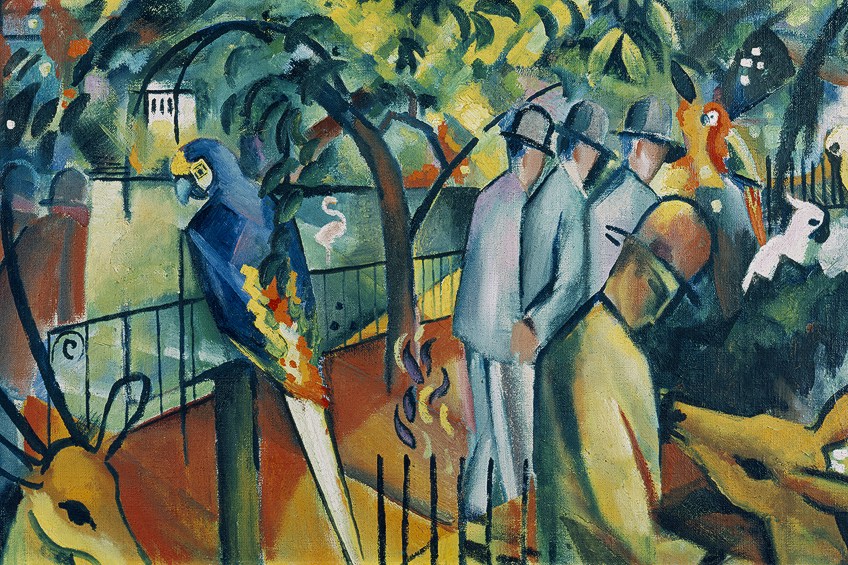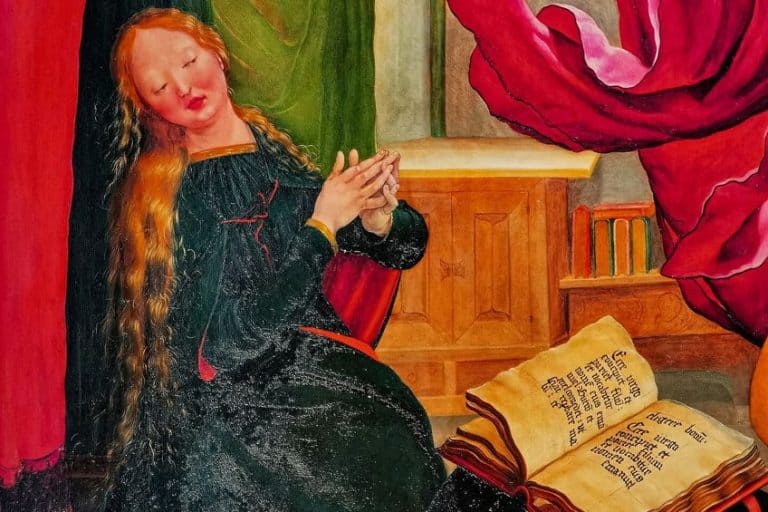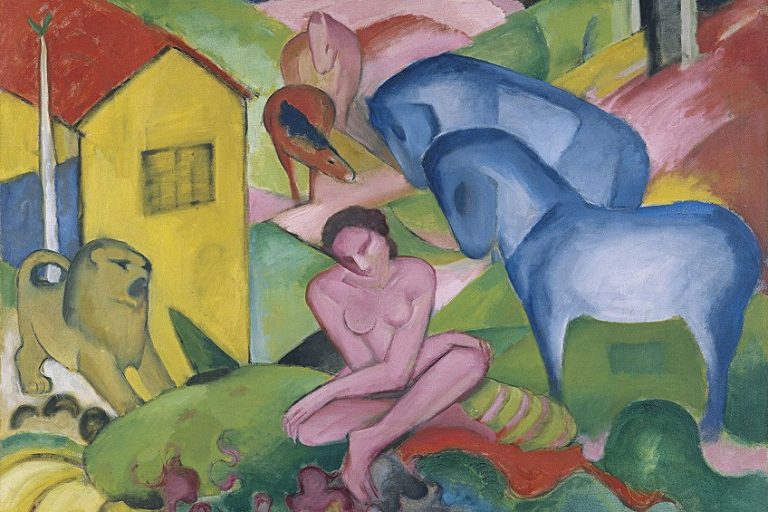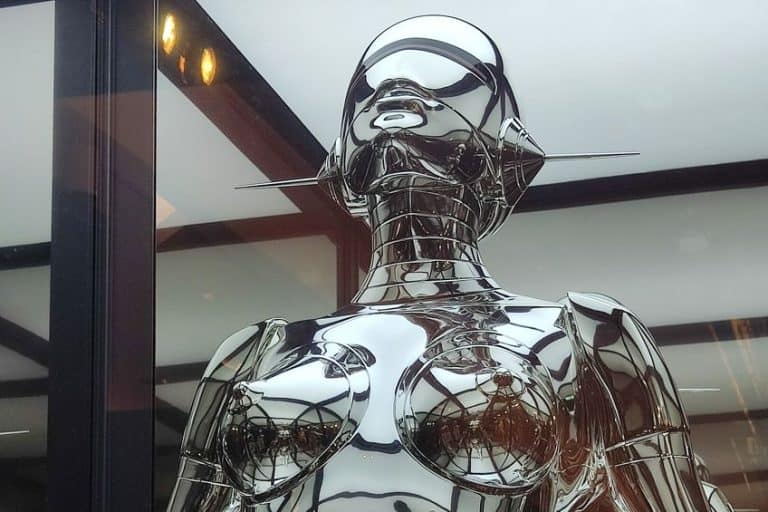August Macke – Looking at German Expressionism Artist August Macke
August Macke was a prominent figure in the Der Blaue Reiter group, a collective of painters from the German Expressionism movement. He lived during a very inventive period in German art, seeing the emergence of the major German expressionism groups as well as the advent of the succeeding avant-garde groups that were emerging throughout Europe. August Macke’s artworks included the aspects of the avant-garde that piqued his attention. He, like his colleagues Otto Soltau and Franz Marc, was a youthful German painter who perished in the First World War.
An Introduction to August Macke’s Paintings and Life
August Macke created an immediately recognized expressionism style, defined by vivid, bright colors and bold draughtsmanship, inspired by modern painters in Germany and France. In a career that lasted less than nine years, he succeeded to generate a diverse body of work in a variety of mediums and genres.
His calm, almost poetic creations include several instances of portrait art, landscape painting, and genre painting.
Macke’s harmonizing imagery creates a powerful feeling of serenity and harmony in his paintings, and his angst-free artwork has been described as “soft expressionism.” He was a significant pioneer of contemporary art in Germany and among the most inventive artists of the early 20th century.
| Nationality | German |
| Birthdate | 3 January 1887 |
| Birthplace | Meschede, Germany |
| Date of Death | 26 September 1914 |
| Associated Movements | German Expressionism, Avant-Garde |
August Macke’s Artworks and Biography
August Macke was a founding member of the avant-garde group Der Blaue Reiter, and a key member of the German Expressionism movement. This group was based in Munich and added innovative artistic contributions to the German art world. His career was cut short by his untimely death when he died on the 26th of September in 1914 during the early days of the first World War.

The Early Life of August Macke
August Macke was born on the 3rd of January in 1887, in the town of Meschede in Westphalia. He was the child of amateur artist and building contractor August Friedrich Macke, and Maria Florentine, who was a native of the Sauerland farming region. The family moved to Cologne soon after August’s birth, where he attended the Kreuzgymnasium and became friends with Hans Thuar, who also became a painter.
He was uninterested in academics and preferred to devote his time to sketching and drawing.
When August Macke was 13, his family relocated to Bonn, where he attended the Realgymnasium and became friends with Walter Gerhardt and his sister, Elisabeth, who would eventually become his bride many years later.

The boy’s earliest creative influences were his father’s sketches, the Japanese prints acquired by his classmate Thuar’s father, and the paintings of Arnold Böcklin, which he encountered on a trip in 1900 to Basel. He attended the Dusseldorf Art Academy from 1904 to 1906 but regarded the educational techniques to be archaic.
Fortunately, he found a more advanced arts institution in the town, where the night lessons were considerably more engaging and he was pushed to explore a variety of various painting and printing methods. He also designed costumes and sets for the city’s theater. He also traveled to Belgium, Holland, and Italy beginning in 1906, thanks to Bernhard Koehler, Elisabeth’s uncle, and a well-known art collector.
The Training of August Macke
August Macke spent most of his artistic life after that in Bonn, with the exception of a few stints at Lake Thun in Switzerland and other journeys to Tunisia, Italy, and the Netherlands. These journeys resulted in August Macke’s first excursion to Paris in 1908.
Here, Koehler exposed him to many of the town’s hyper-modern artworks, including brilliantly colored Fauvism, more ascetic Cubism, and pieces by Robert Delaunay and Paul Cezanne.
He went to a multitude of exhibitions and workshops and met a lot of painters in person. During this period, he spent several months in Berlin studying under renowned painter Lovis Corinth. He wedded his girlfriend Elisabeth in 1909. An example of his artwork from this period is The Artist’s Wife in Blue Hat (1909).
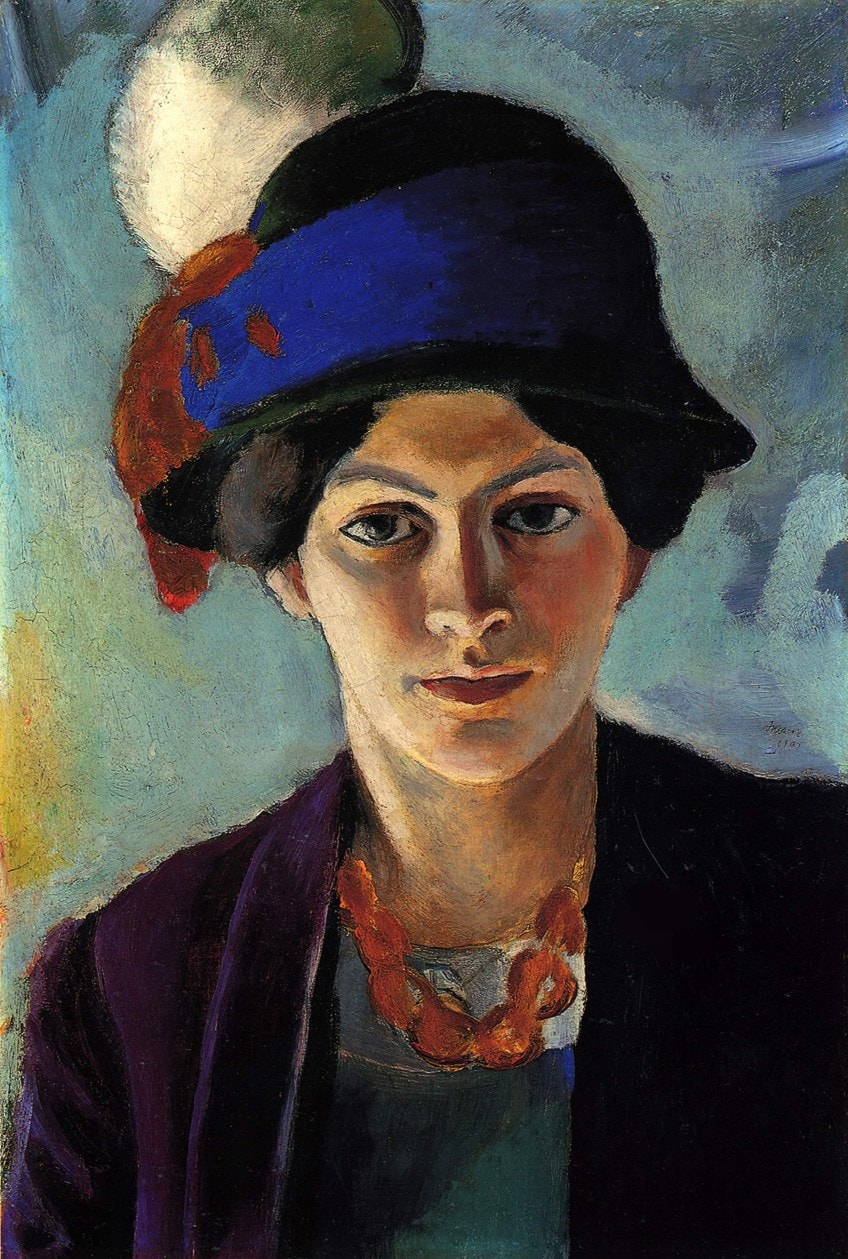
Der Blaue Reiter Group
August Macke met Wassily Kandinsky in 1910 through his connection with Franz Marc, and for a while, they shared Der Blaue Reiter’s non-objective style and metaphysical and metaphorical concerns. It was led by Russian emigrant Wassily Kandinsky, and its other participants included Paul Klee, Franz Marc, and Alexei von Jawlensky.
Many other artists took part in Blaue Reiter shows, notably fauvists Maurice de Vlaminck and Andre Derain, Cubists Braque and Picasso, Russian artists Mikhail Larionov and Natalia Goncharova, and Gabriele Munter, but it was the five main members that epitomized the group’s essence. Some of August Macke’s paintings from this period include his landscape artworks Staudacher’s House at the Tegernsee (1910) and Tegernsee Landscape (1910).

Though the manner of painting varies from one painter to the next within Der Blaue Reiter, some commonalities should be noted. Der Blaue Reiter’s expressionistic work was conceived in part as a coloristic counterpoint to the Cubist Avant-Garde’s monochrome formal studies in Paris.
While Braque and Picasso were limiting their palettes to browns and greys in order to concentrate on form, Der Blaue Reiter painters were emphasizing color and speculating its symbolic implications.
Moreover, individuals of Der Blaue Reiter were closely associated with Cubism experimentation in France, Futurism in Russia and Italy, and a slew of other European offshoot organizations. While all of these contemporary art aesthetic elements became combined in their paintings, they were always inscribed inside the painters’ intensive study of expressive color.

Macke contributed funding to one of the most significant achievements in contemporary art, the publishing of the Blue Rider Almanac (1911), for which he also authored an essay. Furthermore, he helped fund the First German Autumn Salon, the greatest European avant-garde artistic show ever produced in Germany during that period, at the Sturm Gallery in Berlin.
Macke’s encounter with Robert Delaunay in 1912 in Paris would prove to be a watershed moment for him.
From that moment forward, Macke’s painting was affected by Delaunay’s style of chromatic Cubism, which Apollinaire named Orphism. Macke’s Large Bright Shop Window (1912) is a personal version of Delaunay’s Windows (1912) coupled with the continuity of imagery inherent in Italian Futurism.

The Der Blaue Reiter group’s second and last exhibition took place in March 1912. It featured graphic pieces by Munich painters as well as a diverse group of modernists such as Nolde, Kasimir Malevich, Jean Arp, and others. It was apparent from this that there was no cohesive group driving these efforts, and there was no attempt to develop one.
The necessity for these local coalitions had already been supplanted by a European movement, which was now visible everywhere.
The fresh energy that propelled expressionism ahead came primarily from Kandinsky, but also from those surrounding him, like Jawlensky, Klee, and Marc who all desired absolute freedom of the image from the object. Kandinsky’s objective, which he solved beginning in 1912, was to discover a means to create a color harmony that paralleled that of melody. The orchestration of color and the cadence of shapes become the essence of a picture, a result also attained by Delaunay in France.
The Expressionist Style of August Macke’s Paintings
Although a significant contributor to the movement known as German Expressionism, Macke was not particularly engaged in Kandinsky’s philosophical constructs: his letters, particularly, reveal that he had limited tolerance for Kandinsky’s abstract painting. Instead, he established a personal painting style that, although influenced by Cubism, was both representational and vividly colorful.
He believed philosophical musings to be a pointless exercise.
He utilized the limited time he had to fulfill his voracious curiosity about life. As a consequence, his primary topics were ordinary, daily scenes: neither the heightened velocity of 20th-century metropolitan life nor the tranquility of rural landscapes piqued his interest. Examples of this can be seen in Promenade (1913) and People by a Blue Lake (1913).
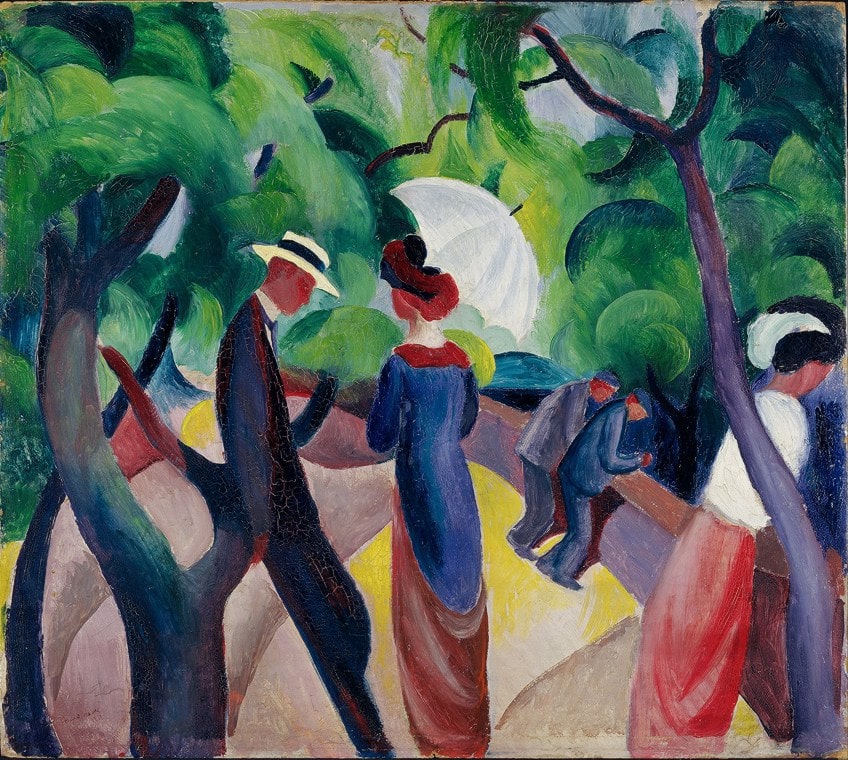
He portrayed contemporary, well-dressed individuals in peaceful, pleasant man-made settings: gardens, thoroughfares, botanical gardens, riverbanks, or shop displays, as well as ballerina and circus settings. August Macke’s artworks, in comparison to other expressionist works, are neither rushed nor tense; instead, they generally portray tranquil discussions, or people sitting quietly, or observing wildlife, or strolling, or even window-shopping.
It’s no surprise that he was attracted to Cologne’s zoological parks, where he depicted children frolicking and tourists wandering amid birds, flamingos, emus, and deer.

These paintings appear to depict a sort of urban paradise within the metropolis, where people may reconnect with the wilderness. Macke’s color palette is more characteristic of Der Blaue Reiter’s art, ranging from vividly vibrant (but never strident) to gently evocative. He was able to create an appealing, exotic aspect by his use of color, even in the most mundane situations he picked.
As a result, he frames his characters with vibrant greenery, turquoise or violet sky, and areas of vivid yellow, implying powerful sunshine. His ladies wear enormous feathered caps, making the city and suburban life appear rich and glamorous.
The Artistic Developments of August Macke
The work of Robert Delaunay inspired him to create a number of Orphism-style artworks with interconnecting shapes and colors, including Colored Composition (1912), Colored Form I (1913), and Colored Form II (1913).

Delaunay’s impact spread to Macke’s figurative works, in which the Frenchman’s “orphic” colors may be seen at times, although Macke’s color pigments are generally brighter and fuller. Macke took part in two notable fine art shows in 1913: the First German Fall Salon in Berlin and the Rhenish Expressionists Exhibition in Bonn. Macke’s second child was born the following year, and the family relocated to a gorgeous lakeside property in Switzerland.
Macke’s Trip to Tunisia
In the spring of 1914, he ventured further afield in quest of more exotic and colorful material. He traveled to Tunisia with Klee and a Swiss friend, the artist Louis Moilliet. The powerful light and colorful environs of North Africa captivated all three, and they passed every day in the scorching heat drawing the palms, mountains, camels, and whitewashed towns they encountered. Macke was particularly drawn to the locals: drawing and painting Arab businessmen selling their products in the alleys and souks, busy waterfront life, and men lounging in cafés such as View into a Lane (1914).
He drew hundreds of sketches in less than a fortnight, which he eventually transformed into some of his finest oil paintings.

The exotic environment of Tunisia, where Macke journeyed in April 1914 with Moilliet and Klee, was crucial in the development of his last luminist style, during which he painted a sequence of paintings now regarded masterpieces.
August Macke’s work may be classified as both Fauvism and Expressionism (in its original German form, which flourished in the two decades between 1905 and 1925).
The paintings are primarily concerned with communicating sentiments and emotions rather than recreating objective truth, and they frequently distort color and shape. However, the brilliant watercolor pictures he created on this trip are possibly his best artistic efforts.

The First World War broke out a few months later. Macke joined the army in early August, only to then be murdered in combat a few weeks later, at the age of 27. All who loved him lamented his death, particularly his dear friend Franz Marc, who would meet the same end only two years later.
August Macke’s Paintings
All through his sadly brief career, August Macke created a signature painting aesthetic – a combination of Fauvism, Impressionism, Cubism, and Orphism – whose sense of harmony, colors, and peaceful imagery served as a counterpoint to the more geometric art and fervent effect of the Die Brucke group in Berlin and Dresden.
August Macke’s artworks may be seen in several of Europe’s top museums and art galleries, and also regional galleries around Germany.
His most renowned landscape artworks include:
- Garden View (1911)
- St Mary’s Church in the Snow (1911)
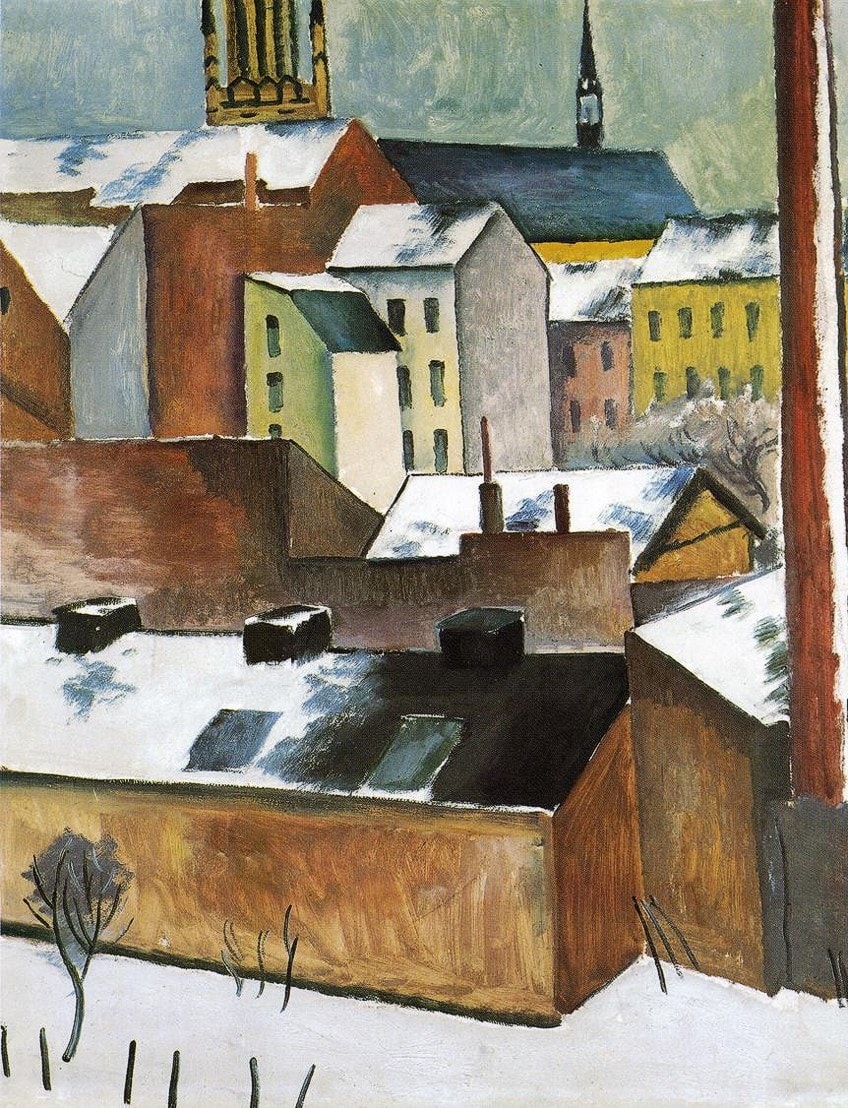
Among August Macke’s most famous portraits are:
- Artist’s Wife with Hat (1909)
- Nude with Coral Necklace (1910)

Macke’s most famous genre paintings include:
- Zoological Garden I (1912)
- Freiburg Cathedral, Switzerland (1914)
- Hat-Shop (1914)

Macke also created a number of woodcarvings and pieces of ceramics, as well as prints (mostly woodcuts and linocuts), for example:
- The Farewell (1913)
- Three Nudes (1913)
- Patterns for embroideries, carpets, wall-hangings, and tapestries.

Further Reading
August Macke’s Artwork career was very short. Yet, there is much to learn about his life beyond what we have shared in this article. If you are interested in learning more about this amazing German painter, then we recommend that you try these books.
August Macke and Switzerland (2013) by Klara Drenker-Nagels
August Macke (1887–1914) is widely considered a pivotal figure in the Blaue Reiter movement. The youthful Expressionist’s period at Rosengarten House on Lake Thun in Switzerland from October 1913 to June 1914 is central to this book. Macke established his unique style of painting, as indicated by the various sketches and oil paintings featured in this collection.
We learn here, as with Cézanne’s Mont Sainte-Victoire, to see the area surrounding Lake Thun as a modernist topos. August Macke and Switzerland, the first book to throw light on Macke’s passion for the nation, provides a comprehensive overview of how geography and nature may inspire not only an artist’s subject matter but also his manner. Readers are also given insights into the journey to Tunisia that Macke, Klee, and Louis Moilliet arranged during their stay in Switzerland in April of 1914.
- Looking at August Macke's time in Switzerland from 1913 to 1914
- The first publication to shed light on Macke’s affinity for Switzerland
- A revealing overview of how a place can inform an artist's style
August Macke (Mega Square) Kindle Edition by Walter Cohen
August Macke was a pioneer of German Expressionism, a style that arose in the early 1900s with the intention of eschewing physical reality in favor of its emotional equivalent, with a special emphasis on depicting gloomy emotions of sorrow and despair. Macke was a hue and shape master, creating eye-catching paintings that elicit a strong empathetic reaction in the observer. He was perfectly at home depicting Tunisia’s sun-drenched alleyways, the overcast sky above Bonn Cathedral, and the faceless masses of a busy railway station. Walter Cohen analyzes the brief life of a painter whose seemingly infinite talent was sadly cut short by his early demise in this riveting essay.
- Examining the brief life of German Expressionism artist August Macke
- A compelling text of an artist whose career was cut short
- Superb artistic reproductions of Macke's finest artworks
And that wraps up our look into the art and life of August Macke. August Macke was a major member of the Der Blaue Reiter group, a group of painters associated with the German Expressionist movement. He lived during a tremendously imaginative age in German art, witnessing the rise of the major German expressionism groups as well as the subsequent avant-garde groups that were forming across Europe. August Macke’s artworks incorporated elements of the avant-garde that captivated his interest. He was a young German painter who died in the First World War, like his friends Otto Soltau and Franz Marc.
Frequently Asked Questions
What Style Were August Macke’s Paintings?
He developed a distinctive painting technique that, while influenced by Cubism, was both figurative and vibrantly colored. He thought philosophical meditations were a waste of time. He made the most of the short time he had to satisfy his ravenous curiosity about life. As a result, his preferred subjects were commonplace, everyday scenes: neither the heightened tempo of twentieth-century urban life nor the peacefulness of rural settings attracted his interest. He represented modern, well-dressed people in serene, attractive man-made surroundings such as parks, thoroughfares, botanical gardens, riverbanks, or store displays, as well as ballet and circus scenes. In distinction to other expressionist paintings, August Macke’s artworks are neither hasty nor tense; instead, they often depict serene dialogues, or people sitting quietly, or viewing animals, or strolling, or even window-shopping.
What Was the Der Blaue Reiter Group?
Der Blaue Reiter’s expressionistic work was created in part as a coloristic counterbalance to Paris’s Cubist Avant-monochromatic Garde’s formal investigations. While Braque and Picasso focused on the form by restricting their palettes to browns and greys, Der Blaue Reiter artists focused on color and speculated on its metaphorical connotations. Furthermore, Der Blaue Reiter members were closely involved with Cubism experimentation, Russian Futurism, and a plethora of other European spinoff organizations. While all of these current art aesthetic components were used in their works, they were always embedded inside the painters’ intense study of expressive color.
How Did August Macke Die?
Macke enlisted in the army in early August, only to be killed in action a few weeks later, at the age of 27. Macke’s tenure was cut prematurely by his death at the frontline in Champagne, France, on the 26th of September, 1914, in the second month of the First World War. Farewell, his final artwork reflects the gloomy tone that prevailed following the onset of war. This was also the year in which he completed the iconic picture Türkisches Café in München (1914). All who loved him mourned his passing, especially his great friend Franz Marc, who died only two years later.
Is August Macke’s Style Regarded as German Expressionism?
August Macke was a well-known German Expressionist artist. German expressionism was a German art style in the early twentieth century that stressed the artist’s inner sentiments or ideas over imitating reality, and was distinguished by simple forms, brilliant colors, and expressive gestures or brushstrokes. It was distinguished by a concentration on emotion and ideas as sources of inspiration. The movement’s foundation stood in sharp contrast to previous movements that emphasized more authentic portrayals of truth and nature.
Isabella studied at the University of Cape Town in South Africa and graduated with a Bachelor of Arts majoring in English Literature & Language and Psychology. Throughout her undergraduate years, she took Art History as an additional subject and absolutely loved it. Building on from her art history knowledge that began in high school, art has always been a particular area of fascination for her. From learning about artworks previously unknown to her, or sharpening her existing understanding of specific works, the ability to continue learning within this interesting sphere excites her greatly.
Her focal points of interest in art history encompass profiling specific artists and art movements, as it is these areas where she is able to really dig deep into the rich narrative of the art world. Additionally, she particularly enjoys exploring the different artistic styles of the 20th century, as well as the important impact that female artists have had on the development of art history.
Learn more about Isabella Meyer and the Art in Context Team.
Cite this Article
Isabella, Meyer, “August Macke – Looking at German Expressionism Artist August Macke.” Art in Context. December 5, 2021. URL: https://artincontext.org/august-macke/
Meyer, I. (2021, 5 December). August Macke – Looking at German Expressionism Artist August Macke. Art in Context. https://artincontext.org/august-macke/
Meyer, Isabella. “August Macke – Looking at German Expressionism Artist August Macke.” Art in Context, December 5, 2021. https://artincontext.org/august-macke/.


